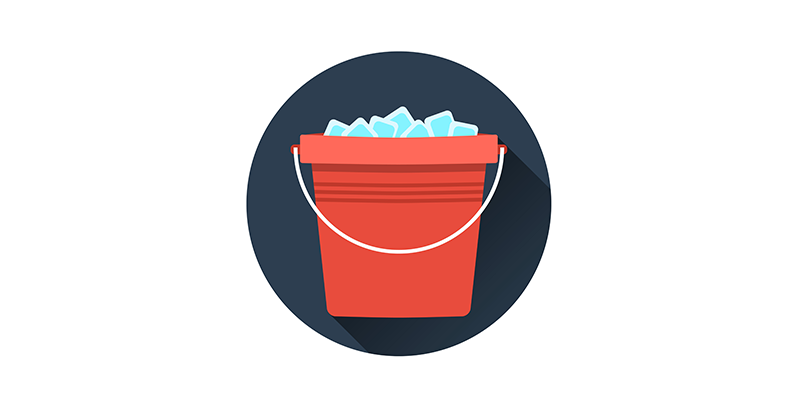All memes lose steam. This summer the #ALSIceBucketChallenge drenched America from coast to coast in one of the most successful meme-driven science crowdfunding campaigns on record. The national umbrella ALS charity is called ALSA, and was founded in 1985, two years after the passage of the Orphan Drug Act. ALSA received the bulk of the #ALSIceBucketChallenge windfall, raising $113.6M to date.
The daily donation hauls for the 30-day interval spanning August 13 to September 12 tell the story:

Coverage is absent before August 13 because ALSA didn’t release daily totals from the genesis of the meme by Peter Frates, a student athlete with ALS from Boston College. The #ALSIceBucketChallenge was actually repurposed from previous incarnations and got national attention when Today Show co-host Matt Lauer accepted professional golfer Greg Norman’s challenge on July 15. The campaign exploded on August 19. For eight consecutive days, daily totals were between $8M-$10M. Heading into Labor Day weekend, the surge began to subside. At that point, ALSA stopped reported daily figures until September 12.
I was off (but not that far off) in my prediction of $125M to $150M. I thought the campaign would power through Labor Day. But by that weekend Facebook feeds were full of wedding pictures and end-of-summer BBQ parties, not #ALSIceBucketChallenge videos. By then Bill Gates’ catalytic #ALSIceBucketChallenge video had over 1 million views. Other ALS charities like ALS-TDI started to receive some of the love, raising $3M to date. At the same time, anti-meme backlash was welling up, as I’m sure was donor fatigue, too.
$113.6M is almost 5 times what ALSA raised in 2013, and 3 times what the NIH spent on ALS research in the same period. Compared to the other 6,999 other rare diseases, it’s not just a windfall but a godsend. That $113.6M is comparable to the annual budgets of the National Institute of Nursing Research ($136.5M) or the National Center for Complementary and Alternative Medicine ($120.7M), the smallest institutes in the NIH family.
No wonder the meme started to get co-opted by NIH advocates, who have a legitimate grievance. Although the annual NIH budget for 2014 is $30B (versus $10B in 1993), a decade of flat budgets since the end of the Doubling (’98 to ’03) led to a 20-25% decrease in real dollars. The average direct costs of a R01, NIH’s workhorse grant for academic lab heads, range from $250-$500k. The typical indirect costs, the university’s cut of NIH grants, can at some institutions be equal to the direct costs. Many disease charities do much better than this. For example, the Michael J. Fox Foundation for Parkinson’s research spends 89¢ of every $1 on research.
So is how will ALSA spend its windfall? That’s the subject for the next post in this series. Right now I want to focus on what can the other 6,999 rare diseases can learn from the #ALSIceBucketChallenge campaign. Can they bottle some of that magic for their own disease? The answer appears to be yes! Even while the the #ALSIceBucketChallenge wave was cresting, a giant axonal neuropathy (GAN) foundation called Hannah’s Hope Fund started a derivative meme called #LetsWhipGAN:
The psychology of the challenge is preserved but the physical consequences are whipped cream in the face versus icy water dumped on the head. Here’s another example of the #ALSIceBucketChallenge meme mutating. A Sanfilippo Type C (aka MPSIIIC) charity called Jonah’s Just Begun created their own derivative meme of defiantly posing with purple nail polish applied to the middle finger:
Our message to Sanfillipo syndrome with love to Jill Wood and a donation to @JJB4CURE #raredisease #CureSanfilippo pic.twitter.com/twMvLwLcVZ
— Christy Collins (@_chrisco) September 7, 2014
The possibilities are, of course, endless.
At the 3rd annual Global Genes Patient Advocacy Summit last week, Prader-Willi Syndrome advocate Keegan Johnson led a session called the Unstoppable Charity. He led a brilliant deep dive on fundraising tactics, including marketing concepts like the goal gradient effect, which basically states that people are more likely to donate to a campaign that is 80% funded versus 20% funded. Keegan ended by invoking the #ALSIceBucketChallenge. The lesson for him? No challenge is unattainable. As echoed by others at the summit:
"If you're out of hope, please borrow ours" says an #NGLY1 #RareDisease mom at #RARETribute2014 pic.twitter.com/lRCzuJ91C9
— Project Alive (@Projectalive) September 14, 2014
That’s the lesson all scientists and rare disease advocates should take note of. We all want cures. We all know that basic science discoveries are the root of all cures. The #ALSIceBucketChallenge won’t be the last meme-driven fundraising campaign, so onwards to the next breakthrough.


